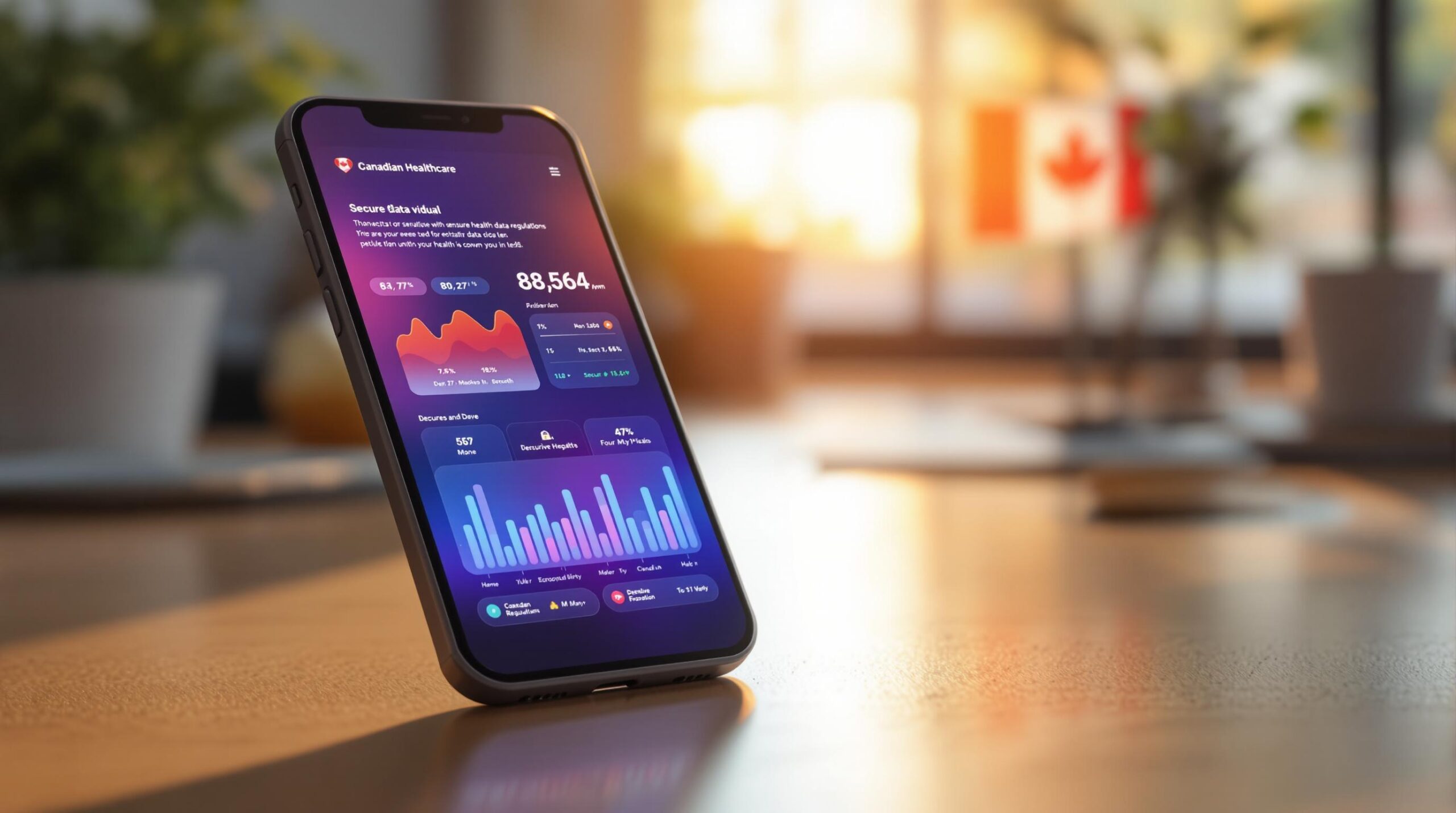
Building a healthcare app in Canada? You must comply with strict privacy laws like PIPEDA and PHIPA, which protect sensitive health data. Non-compliance can result in fines up to $100,000 CAD per violation. Here’s what you need to know:
- Key Security Features: Use AES-256 encryption, biometric authentication, and access controls to safeguard data.
- Compliance Steps: Collect only necessary data, ensure user consent, and follow clear data storage rules (e.g., use Canadian data centers).
- Privacy Tools: Implement automatic logout, user activity tracking, and data deletion protocols.
- Testing & Maintenance: Regular security audits, penetration tests, and updates are essential to stay secure and compliant.
Understanding Canada’s Privacy Law (PIPEDA …
Canadian Health Data Privacy Laws
Understanding privacy laws in Canada is key when creating secure healthcare apps. Two main regulations govern the protection of health data: PIPEDA (Personal Information Protection and Electronic Documents Act) and PHIPA (Personal Health Information Protection Act).
PIPEDA and PHIPA Overview
PIPEDA sets out rules for handling personal information in commercial activities across Canada. It requires organizations to adhere to 10 core principles:
- Accountability
- Identifying purposes
- Consent
- Limiting collection
- Limiting use, disclosure, and retention
- Accuracy
- Safeguards
- Openness
- Individual access
- Challenging compliance
While PIPEDA applies across the country, provinces like Ontario enforce PHIPA to specifically address health-related data. These laws directly shape the compliance measures for mobile healthcare apps.
Mobile App Compliance Guidelines
A 2012 survey revealed that 57% of users uninstalled or avoided apps due to privacy concerns. To comply with privacy laws and address user trust, developers should:
-
Communicate Data Practices Clearly
Privacy policies must explain data collection practices in simple terms, and apps should secure clear user consent. -
Minimize Data Collection
Only gather what is absolutely necessary. Surveys show that 90% of Canadians are uneasy about excessive data requests. -
Implement Strong Security Measures
Protect user data with tools like:- Strong encryption for storage and transmission
- Secure authentication methods
- Regular security audits
- Automated data deletion when users uninstall the app
Legal Consequences
Failing to meet these regulations can lead to severe penalties, including:
- Fines of up to $100,000 CAD for each PIPEDA violation
- Possible legal action via referral to the Attorney General
- Mandatory reporting of data breaches
- Damage to an organization’s reputation
Recent investigations have highlighted major companies facing scrutiny for PIPEDA violations. With 92% of Canadians expressing serious concerns about how their data is handled, following these laws is not just about avoiding penalties – it’s also about earning user trust.
Core Security Features for Health Apps
Protecting sensitive health data requires strong security measures integrated into every layer of mobile apps. Here’s a breakdown of the key components necessary to meet Canadian privacy standards while aligning with broader app security protocols.
Data Encryption Methods
Encryption plays a critical role in safeguarding health data. AES-256 encryption provides stronger protection than AES-128 in three key areas:
- Data at Rest: Use full-disk or virtual disk encryption with strong, unique passwords.
- Data in Transit: Secure data transfers with reliable encryption protocols.
- Portable Storage: Ensure external devices are encrypted.
The Information & Privacy Commissioner of Ontario notes that properly encrypted devices, even if lost or stolen, do not result in a privacy breach.
User Authentication Systems
Multi-factor authentication (MFA) is essential for verifying user identity. Combine biometrics (like Touch ID or Face ID) with other verification methods. For example, Imprivata’s OneSign integrates seamlessly with Microsoft Azure to enhance authentication processes.
User Permissions and Activity Tracking
Strong access controls and monitoring systems are essential for maintaining security and accountability:
- Enforce strict permission settings, use automatic session timeouts, and conduct regular audits.
- Track activity by logging login attempts, monitoring data access patterns, and recording system changes.
- Provide user training on recognizing threats and handling data securely.
These measures help create secure and privacy-compliant mobile health systems.
sbb-itb-7af2948
Building PIPEDA/PHIPA Compliant Systems
Creating mobile health apps that align with Canadian privacy laws demands careful attention to data management and system design. Below, we break down the key steps, from data collection to recovery.
Data Collection Limits
To comply with Canadian privacy laws, limit data collection by:
- Gathering only the health information that’s absolutely necessary
- Setting up automatic deletion schedules
- Using data anonymization techniques
- Explicitly tracking user consent
"Canadian privacy laws require you to restrict your data collection to what is needed for an identified purpose that exists now and delete data that you no longer need for the original purpose for which it was collected." – Office of the Privacy Commissioner of Canada
Cloud Storage Compliance
Storing data securely in the cloud is critical. Follow these guidelines to meet compliance:
| Requirement | Implementation |
|---|---|
| Data Residency | Use Canadian data centers with SOC 2 Type II certification |
| Encryption | Apply AES-256 for stored data and RSA for asymmetric encryption |
| Access Control | Set role-based permissions and maintain audit logs |
| Network Security | Use VPNs and segment networks for better protection |
Additionally, separate sensitive health data from general user information to apply tailored security measures based on the data’s sensitivity.
Data Backup and Recovery
Secure storage is just one piece of the puzzle. Protecting data from loss and ensuring recovery capabilities are equally important. Here’s how to approach it:
1. Automated Backup Protocols
Set up encrypted, automated backups across multiple storage locations. Use versioning to maintain data integrity and allow rollbacks if needed.
2. Disaster Recovery Plan
Develop a detailed plan for handling server outages, data corruption, or breaches. Regularly test this plan through simulated recovery exercises to ensure readiness.
3. Data Restoration Process
Implement secure restoration methods that keep data encrypted during recovery. Always verify the integrity of restored data to avoid issues.
"The Personal Health Information Protection Act (PHIPA) requires that, as a health information custodian (custodian), you must take reasonable steps to ensure that personal health information in your custody or control is protected against theft, loss and unauthorized use and disclosure, and that the records containing the information are protected against unauthorized copying, modification or disposal." – Information and Privacy Commissioner of Ontario
Conduct regular security audits to ensure your system remains effective. Updates should address new vulnerabilities and incorporate advancements in technology.
Health Data Security in Development
When developing applications, security should be a priority at every stage to protect sensitive health data.
Security-First Coding
Here are some key measures to ensure secure coding:
| Security Layer | Implementation Requirements |
|---|---|
| Data Storage | Use Android Keystore System or iOS Keychain Services |
| Communication | Enforce SSL/TLS 1.2+ with certificate pinning |
| Authentication | Implement biometric authentication and multi-factor systems |
| Code Protection | Apply code obfuscation frameworks |
In addition to these layers, developers should adopt these practices:
- Follow the OWASP Mobile Security Guidelines.
- Validate inputs on both client and server sides.
- Use AES-256 encryption to secure local storage.
- Remove unnecessary code to minimize potential vulnerabilities.
- Use parameterized queries to protect against SQL injection attacks.
Once secure coding practices are in place, rigorous testing is critical to ensure these measures work as intended.
Security Testing Protocol
With the heavy reliance on mobile devices, testing for security vulnerabilities is more important than ever. A robust testing process should include:
- Automated Security Scans: Use tools like Static Application Security Testing (SAST) and Dynamic Application Security Testing (DAST) in your CI/CD pipeline to catch vulnerabilities in both static and runtime environments.
- Manual Security Audits: Have security experts perform penetration testing to uncover issues that automated tools might miss.
- Continuous Monitoring: Set up systems to monitor for potential security issues in real-time, addressing them before they escalate.
These steps help ensure the application is secure and ready for integration with external services.
External API Security
Integrating third-party APIs introduces additional risks, making it essential to maintain strict security protocols:
- Use API gateways with strong access controls.
- Require JWT-based authorization for all API calls.
- Conduct regular audits of third-party components.
- Apply updates immediately when vulnerabilities are identified.
Before integrating any external API, perform a thorough security review. This includes checking documentation, conducting security tests, and ensuring compliance with privacy regulations.
User Privacy Protection
Safeguarding user privacy in healthcare apps is a top priority, especially when aligning with Canadian privacy laws. Surveys reveal that 65% of Canadians view personal information protection as a pressing concern for the next decade. By combining solid security measures with thoughtful user privacy controls, developers can better protect against data breaches.
User Consent Systems
Transparent consent processes are a must for healthcare apps. Users need to clearly understand what personal health data is collected and how it will be used. Here’s how consent can be managed effectively:
| Consent Element | Implementation Approach |
|---|---|
| Initial Consent | Provide a clear privacy policy upon download with icon-based layers |
| Ongoing Consent | Use real-time notifications and alerts for sensitive actions |
| Consent Renewal | Allow users to define when consent should be refreshed |
| Data Sharing | Request explicit approval for cross-border data transfers |
Dynamic consent systems are especially useful for addressing privacy concerns. For instance, when accessing location data, apps should include visual cues and clear explanations about why the data is needed and how it will be used.
Built-in Privacy Features
Privacy should be an integral part of the app’s design. Key features include:
- Minimal Data Collection: Gather only the information necessary for the app to function.
- Geographic Restrictions: Follow province-specific storage rules, such as those in British Columbia and Nova Scotia.
- Cross-Border Controls: Ensure users provide express consent for data transfers outside their province, including Ontario.
- Visual Privacy Indicators: Use color-coded alerts and other visual tools to inform users about privacy settings.
Data Rights Management
Giving users control over their personal health data is non-negotiable. A comprehensive data rights system should cover:
1. Access Management
Provide users with straightforward tools to view and edit their personal information. Include detailed logs that show when data was accessed or modified.
2. Deletion Protocol
Establish secure methods for data removal that comply with PIPEDA and PHIPA. This should cover both user-initiated deletions and automatic purging after retention periods.
3. Data Portability
Enable users to transfer their health information securely to other platforms or providers, ensuring privacy is maintained throughout the process.
With nearly 90% of Canadians worried about businesses collecting excessive personal information and risking data security, these privacy measures are essential. They not only enhance user control but also strengthen the app’s overall security framework.
Conclusion
Creating secure healthcare apps in Canada requires strict compliance with privacy laws and careful attention to technical details. Failing to meet these standards can lead to severe legal penalties, making it crucial to prioritize security from the start.
This legal environment calls for a strong security foundation, built around three main pillars:
| Pillar | Key Requirements | Impact |
|---|---|---|
| Security Infrastructure | Encryption & Multi-Factor Authentication (MFA) | Safeguards sensitive health data |
| Compliance Framework | Alignment with PIPEDA/PHIPA | Meets legal requirements |
| User Privacy Controls | Access and deletion protocols | Strengthens user confidence |
Modern healthcare apps rely on these pillars to implement effective and transparent data protection strategies. They ensure both the security of sensitive health information and compliance with Canadian privacy laws.
To stay ahead, healthcare app developers should focus on:
- Frequent Updates: Regular vulnerability checks and security patches to counter new threats
- Clear Privacy Policies: Open communication about data usage to maintain stakeholder trust
- Ongoing Compliance: Keeping up with changing privacy laws to remain legally sound


